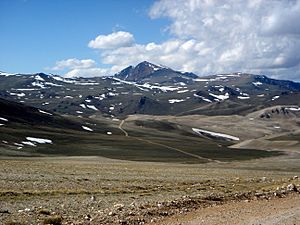Alpine climate facts for kids
Alpine climate is the average weather found in very high places. These are usually mountain areas located above the tree line. The tree line is the elevation where trees stop growing because it's too cold or windy.
In an alpine climate, it is always quite cold. Even during the warmest month of the year, the average temperature never goes higher than 10 °C (50 °F). This makes it a very unique and challenging environment.
Contents
What is Alpine Climate?
Alpine climate is a type of mountain or highland climate. It's found in regions with high altitude, meaning they are very far above sea level. These areas are often called the "alpine zone."
The main feature of this climate is its cold temperatures. It also has strong winds and high levels of ultraviolet radiation from the sun. Snow and ice are common throughout the year.
Where is Alpine Climate Found?
You can find alpine climates on high mountains all over the world. Some famous examples include:
- The Himalayas in Asia
- The Andes in South America
- The Alps in Europe
- The Rocky Mountains in North America
- Parts of the Southern Alps in New Zealand
These climates exist because of the high elevation. As you go higher up a mountain, the air gets thinner. Thin air holds less heat, which makes the temperatures much colder than at lower elevations.
Key Features of Alpine Climate
Alpine climates have several distinct characteristics:
- Cold Temperatures: As mentioned, temperatures rarely rise above 10°C (50°F). Winters are very harsh and long.
- Strong Winds: High altitudes often experience powerful winds. These winds can make the air feel even colder.
- High Radiation: The thinner atmosphere at high altitudes means less protection from the sun's ultraviolet (UV) rays. This can be dangerous for living things.
- Low Air Pressure: The air is thinner, meaning there is less oxygen. This can make it hard for people and some animals to breathe.
- Lots of Snow and Ice: Because it's so cold, precipitation often falls as snow. Many alpine regions have glaciers and permanent snowfields.
- Short Growing Season: Plants have a very short time to grow and reproduce due to the long, cold winters.
Life in Alpine Climates
Despite the harsh conditions, many plants and animals have adapted to live in alpine climates.
- Plants: Alpine plants are often small and grow close to the ground. This helps them avoid strong winds and stay warm. They might have thick leaves or fuzzy stems to protect them from the cold and UV radiation. Examples include alpine grasses, mosses, and small wildflowers.
- Animals: Animals in alpine regions have special ways to survive. Some grow thick fur or feathers for insulation, like the yak or mountain goat. Others, like marmots, hibernate during the long, cold winters. Birds might migrate to lower elevations in winter.
These unique ecosystems are very fragile. They are important for biodiversity and often act as sources for major rivers.
See also
 In Spanish: Clima alpino para niños
In Spanish: Clima alpino para niños


